Introducing the latest myCWT product and service enhancements
Building on our digital, omnichannel myCWT platform, our new products and services will simplify travel management for you and your employees – anytime, anywhere, anyhow.
Note: Featured services may not be available in your country at this time. Please reach out to your CWT representative for more details.
Hear from Chief Product Officer, Erica Antony as she shares the key product highlights of 2024, along with the key areas driving innovation.
-

2040: Baseline, Boom or Bust
As we enter an era of rapid transformation and unprecedented challenges, it is essential for travel managers, meeting & event planners, and corporate decision-makers to look ahead and frame our current strategic thinking with a clear vision of the future. Business travel and meetings and events (M&E) are poised for significant change over the next decade and a half, driven by a complex interplay of sustainability goals, technological advancements, evolving work models, and geopolitical dynamics.
In this paper to mark the 10th anniversary of our Global Business Travel Forecast, we explore, for the first time, a long-term vision of the future and potential trajectories through three distinct scenarios, each offering insights into how these forces should affect policy-making, budgeting and priorities. By examining these scenarios, we can better understand the diverse possibilities that lie ahead and the strategic imperatives required to thrive in each potential future.
Based on trajectory data analysis and interviews with industry leaders, behaviorists and climate tech founders, this forward-looking approach enables us to anticipate changes, strengthen our strategies, and make informed decisions that align long-term objectives. It is through this lens of foresight and adaptability that we can build resilience, seize opportunities, and navigate the complexities of the future.
We invite you to reflect on the insights presented, and consider how your organization can prepare for the opportunities and challenges that lie ahead. Together we can ensure that travel and meetings remain catalysts for growth, scalability and sustainable practices.
- Scenario development is both an art and a science
- Megatrends Shaping the Future of Business Travel, Meetings and Events
- Sustainability goals the new crux of corporate policy
- Technology Revolutionizes Travel Management
- Modern work models spark new travel patterns
- Changing demographics open doors to new opportunities
- Three Scenarios: Base case, boom and bust
- Future-proofing strategies

-

CWT GBTA Global business travel forecast 2025
When it comes to pricing, global business travel has finally reached an enduring, higher baseline. Prices will continue to rise in 2025, but only moderately, so expect a period of normalized growth.
However, this pricing environment, one of marginal gains and price regularity, is fragile. Global leisure travel has now realized a lot of its pent-up demand, while corporate travel has been resurgent, with 2024 edging at preCovid levels.
There are many factors at play, whether its volatile oil prices, labor costs and constraints, inflationary pressures, and geopolitical factors. As this elevated baseline edges upwards, albeit marginally, travel budgets will come under increased scrutiny, especially as travel patterns and attitudes change.
It’s why business travel can’t be viewed in a silo, and the true value to an organization must be fully realized. This forecast can help with those calculations.

-

Capitalize on emerging technologies in corporate travel
Technological advancements are accelerating at an unprecedented pace. How will emerging innovations like Generative AI, blockchain, and self-sovereign identity (SSI) transform corporate travel?
BTN and CWT probed global CEOs, travel managers, industry consultants and tech experts on the promises, questions, and expectations these innovations raise and how they are set to reshape traveler experience, cost control and service delivery in corporate travel and events.
Download and discover
- The technologies that will have the greatest impact on corporate travel in the next 2-5 years
- How these emerging technologies are poised to control costs, enhance service and security, and boost efficiency
- The critical challenges, opportunities, risks and roadblocks each innovation raises
- What travel managers, buyers and experts anticipate from these innovations

-

Napa Valley – Discover California’s sun-drenched wine region
Welcome to California’s wine country, often known as one of the most heavenly places on earth. Napa Valley is the epitome of the beautiful American countryside with gorgeous scenery and award-winning wines. What do wine and meetings and events have in common? With experience and experimentation, you uncover the most exquisite combinations.
Beyond the beautiful venues, excellent wineries and Michelin-starred restaurants, thousands of bedrooms and close to 500,000 square feet of meeting and event space, Napa brings over 200 days of sunshine each year, providing a blank canvas to create something quite spectacular.
Unveiling four seasons’ new resort
Four Seasons Hotels and Resorts is bringing one of the most acclaimed venues to life, with some of the freshest and novel meetings and event spaces to Napa Valley. The luxury hospitality company boasts great presence around the world, and now they are bringing “farmhouse chic” to Napa Valley. From naturally lit barns for private parties or events to intimate dinners, bringing the farm to table concept alive in authentic wine cellars. Some of the venues largest event spaces reach up to 2,645 square feet, hosting up to 220 for a sit-down banquet.

Incentive travel, napa style
Incentive travel is about making rewards personal. Napa Valley offers an unforgettable experience with luxury accommodations, wine tasting experiences by car or helicopter, cooking masterclasses with ingredient foraging experiences and gala dinners. Can you see yourself here?

Wine and dine in ‘the valley’
The premium, sun-drenched valley brings some of the best dining experiences. It is not all sparkling wine and caviar. Napa Valley is an agricultural region, ensuring some of the locally grown produce is at its seasons’ prime. You can find picnic-worthy baguettes to high-end fine dining and fantastic wine tasting experiences.
From Michelin-starred restaurants to cheap gourmet eats, there is a range of different dining experiences for team dinners:
Redd Wood – Napa’s local pies:
Copious amounts of wine tasting may leave you wanting a less indulgent meal for lunch or dinner; why not try one of Napa’s local pies? Redd Wood by Michelin Star Chef Richard Reddington is a strong contender. A cozy nook offering locals and those in the known some of the best pizzas, cured meats and fresh pies in a contemporary setting.
TORC – Affordable fine dining:
Bringing together masterfully created dishes, made with premium ingredients without the premium price tag, TORC provides a lively atmosphere with gourmet food to match. From bar snacks to a three-course meal with wine pairings, you can expect a delightful experience here.
Oenotri – Local and sustainable dining:
Downtown Napa has a lot to offer, including this Southern Italian gem. Blending the European traditions with wine and local produce. From homemade pasta, a large variety of artisan salami, fresh fruit, vegetables and herbs all harvested from the restaurant’s garden.

It is time to host your next meeting or event in Napa Valley
-
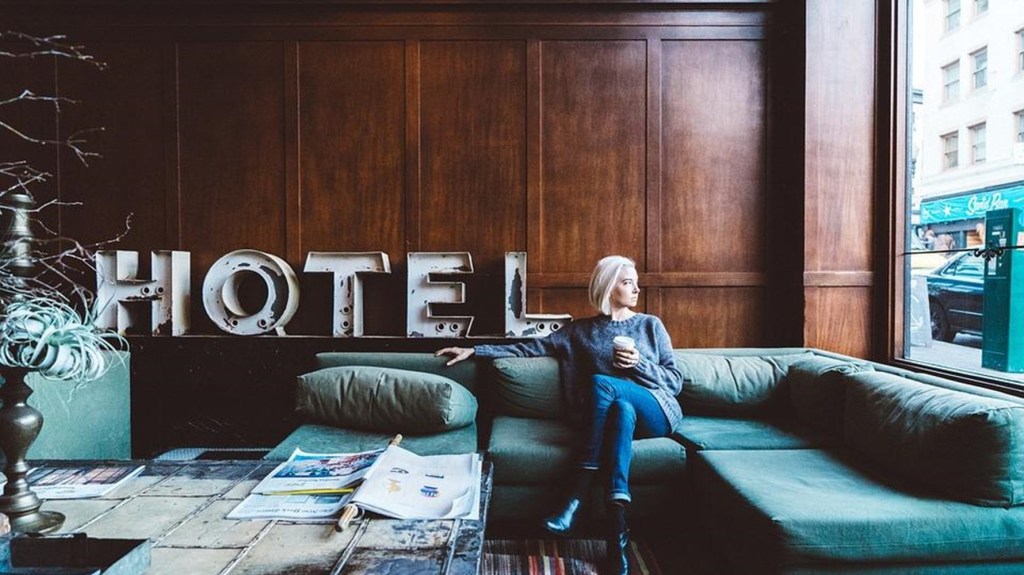
RoomIt by CWT research reveals key differences in business traveler hotel preferences by country
According to research commissioned by RoomIt by CWT, the hotel distribution division of CWT, the B2B4E travel management platform, business travelers want different hotel experiences based on the country they are from.
The survey compiled responses from 660 business travelers from nine countries to identify what influences them to choose a particular hotel during the booking process. The results revealed that globally, having access to Wi-Fi (84%), room rate (81%), distance from business site (81%) and breakfast (79%) are the most important influences. A few of the key differences between countries were also revealed, such as business travelers from the UK and Germany are the most swayed by having access to a health club (44%) and loyalty programs are the most important to those from Mexico and Germany (46%).
“We continually work to understand business travelers’ specific wants and needs so we can offer the accommodations that will improve their satisfaction,” said Scott Hyden, SVP and Chief Experience Officer of RoomIt. “We know that you have to get the basics right in order to maximize compliance and reduce travel spend.”
Several other notable takeaways from the results — business travelers from Germany are most likely to be persuaded by photos (56%) compared to other countries while travelers from France are the least likely to experiment with new hotel brands (26%).
Travelers from Mexico are less likely to use their company’s booking tools (24%), compared with those from Canada (35%). German travelers rely most on having someone else book their travel (41%) or going offline to speak with a travel agent (40%) compared to US travelers (27% and 22%, respectively).
Overall, business travelers are more likely to stay at upper midscale to upper upscale properties, but there are key regional differences. Travelers from India and Australia are more likely to stay in luxury properties (35% and 25%), while Mexico, the US and Italy travelers are more likely to stay in upper midscale properties (35%, 32% and 27%).
Globally, when asked what attributes best describe the ideal hotel accommodation, results show that the hotel and service are stronger drivers than amenities, image or location. Quality (44%), trustworthiness (38%), convenience (40%), quietness (30%), affordability (28%) and coziness (28%) resonate the strongest. Regionally, quality is most important to India (63%), the US (44%), Canada (40%), and the UK (39%). France prefers coziness and quiet the most (49% and 39%), while Mexico ranks trustworthiness the highest (54%).
The survey
The RoomIt by CWT survey was conducted through a web-based survey between the 28th of November and the 14th of December, 2018. Survey data was collected from more than 660 business travelers from the United States, Canada, United Kingdom, India, France, Italy, Germany, Australia, and Mexico. Business travelers were defined as people who spent at least one night away from home traveling for business and identified themselves as managed or unmanaged business travelers over the age of 18.
CWT is a leading global partner in business travel, meetings, and events. Operating across six continents, we deliver sustainable, tailored solutions that help organizations connect, engage, and thrive in an evolving world. Our myCWT platform integrates advanced technology with human expertise to simplify travel and enhance traveler and attendee experiences. Extensive global coverage, seamless data integration, AI-driven analytics, and carbon-conscious travel tools enable businesses to optimize their travel and meetings programs while delivering measurable value.
With 150 years of industry experience and a deep commitment to partnership, CWT collaborates with clients to shape the future of business travel and events, making them more efficient, responsible, and impactful.
RoomIt by CWT
RoomIt by CWT is the hotel distribution division of CWT. Every day we match travelers with the right room at the right rate, and every minute we book over 30 hotel rooms. We also provide travelers with the amenities and loyalty programs they want, while helping organizations control their budget and improve travel oversight. -

By the book – How to create a booking experience business travelers crave
To ensure traveler satisfaction is among the top five goals for travel managers, RoomIt commissioned research to determine exactly what business travelers around the globe crave from their hotel booking experience.
While no booking method was perfect, business travelers felt online travel agencies provided the best overall experience. In fact, almost half of all business travelers surveyed said they preferred booking through online travel agencies over any other hotel booking method.
Despite business traveler’s preference for online travel agencies, over half visit two or more sites and 26% admit to visiting three or more, which means no booking method is superior at retaining shoppers.
Clearly, travelers have booking needs that aren’t being met by their online booking tools. But what exactly are these needs and how can you help meet them? Here are five ways.
- Cover the basics – It’s probably no surprise but travelers all across the world rank price, breakfast, WIFI and distance from the destination as the top attributes they look for when booking a hotel. Many companies include WIFI and breakfast in their negotiations, but if you want to avoid that additional expense you may want to partner with or promote hotel brands that offer free breakfast or WIFI.
Our research shows that business travelers also want these amenities clearly called out in their online booking tools along with cancellation policies, and they prefer using icons for these call-outs, which shouldn’t be too surprising in our emoji-filled world.
In a separate study RoomIt did with GBTA, 73% of travelers said their top challenge when booking hotels through their corporate channels is finding a hotel near their destination. This represents the largest challenge to travelers regardless of region. The good news is it can actually be addressed pretty easily:- Partner with hotel brands with a large global presence.
- Integrate third-party hotel content and TMC sourced accommodations into your program. This will provide access to more properties near travelers’ destinations and a wider variety of rates.
- Use online booking tools or apps that allow travelers to find hotels on a map near their destination’s address.
- A matter of scale – Hotel scale strongly impacts traveler decisions, so what scale of properties are your travelers booking? The majority of travelers book between the upper midscale and upper upscale tiers. However, preferences vary by region. In India, travelers are more likely to prefer luxury hotels, and Australians book more economy accommodations than other regions.
To meet local needs and increase compliance on a global scale, partner with brands that offer a variety of property types. Furthermore, you must clearly call out if you restrict any segments, like luxury, from being booked in your policy. - Sell the perks of your preferred partners – When it comes to selecting hotels, business travelers value quality, convenience, affordability, trustworthiness and quiet. Ensure your hotel partners meet these needs and then actively market your preferred hotel brands to your employees. You can partner with preferred vendors at travel fairs to reinforce these messages or highlight your hotel partners through automated email tools, intranet banners or display messaging or ads.
Worried you’re going to overdo it? Don’t be. While many travel managers are concerned about over-communicating to their travelers, in reality, they probably aren’t communicating benefits enough. 69% of companies surveyed in our joint study with GBTA said they require preferred hotels to be booked by travelers while only 30% of travelers knew this. - Integrate reviews – No booking experience is complete without hotel reviews. 70% of travelers said they would consider booking an accommodation based off a recommendation, which ranks it as the second most compelling influence on traveler booking decisions.
Integrating business-travel friendly reviews into your tools helps travelers make the right decisions and mitigates against that undesirable “shopping-around” behavior. - Improve the booking experience for a better hotel program – Having total control over your travelers, although tempting, is never going to happen, but you can foster a better hotel booking experience. Improvements to experience compel travelers to book within corporate channels, which empowers you to improve traveler decision-making, which then helps you achieve your goals.
- Cover the basics – It’s probably no surprise but travelers all across the world rank price, breakfast, WIFI and distance from the destination as the top attributes they look for when booking a hotel. Many companies include WIFI and breakfast in their negotiations, but if you want to avoid that additional expense you may want to partner with or promote hotel brands that offer free breakfast or WIFI.
-

Experience is king – Is your policy up to scratch?
After several consecutive years of shrinking travel perks, organizations are reinvesting in creating a more comfortable journey for their travelers. They’re well aware of the importance of looking after their employees’ wellbeing. After all, at companies where travel is an important part of the job, travel benefits can be a determinant factor to retain and attract top talent.
As a consequence, the premium cabins keep growing, upper scale hotels are back in the programs, and, overall, big data and predictive analytics are helping travel managers to provide a better experience for their colleagues while still keeping expenses on track.
But what happens when it comes to travelers’ preferences? Are travel managers considering them and adapting their policies to suit?
This year we commissioned a study to explore, among other topics, some of the most frequent scenarios business travelers are confronted with. Do they prefer the window or the aisle seat? Would they rather miss a flight or lose their luggage? Are they still mainly using traditional taxis or are ridesharing services gaining traction? These are some of the questions we asked over 2,700 travelers worldwide.
According to our research, two-thirds of business travelers prefer window seats over aisle seats. That rises to 71% in Asia Pacific, and falls to 59% in the Americas, with Europeans in line with the global trend of 65% window over aisle.
Globally, a narrow majority of business travelers would prefer to miss their flight rather than be separated from their luggage – with travelers from the Americas showing the strongest preference at 54%, European travelers at 52%, and travelers from Asia Pacific split down the middle.
When it comes to ground transportation, 54% of travelers still prefer traditional taxis over ridesharing services like Lyft or Uber. But there are strong regional differences. A full 69% of Europeans prefer taxis – almost exactly the reverse of American travelers, 63% of whom prefer rideshare services. Asia Pacific travelers are more evenly split, with 56% preferring taxis.
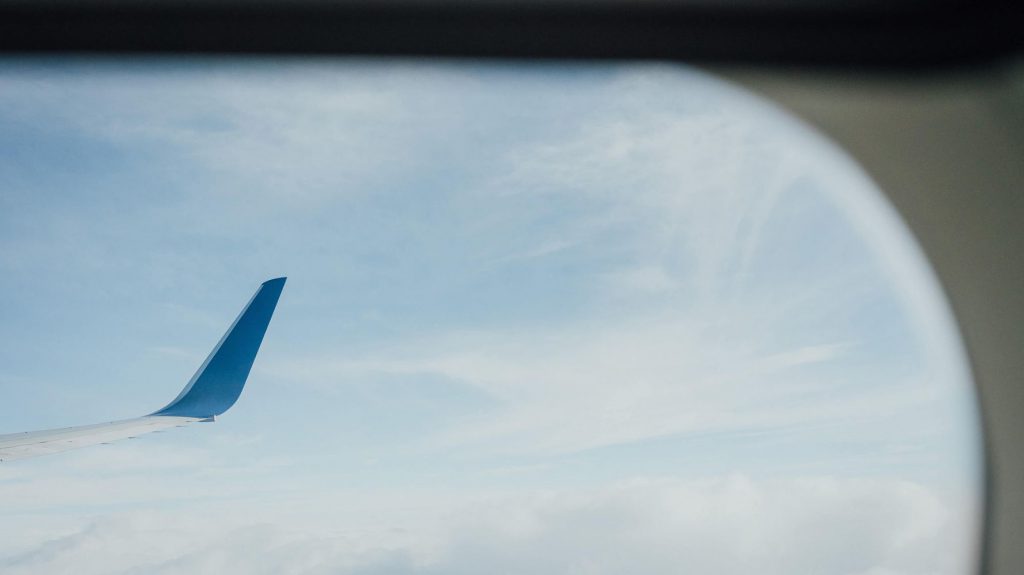
Do European travel policies take into consideration travelers’ preferences?
With these findings in mind, we decided to ask our European clients a few questions to see how those preferences fit with their travel programs. Are they taking them into consideration to craft their travel policies?
Regardless of whether they are fans of window or aisle seats, it’s safe to assume that none of us will ever go for the middle seat, something as small as allowing your travelers to pay extra to choose their preferred seats can make a big difference to their overall experience and ease the pain of not indulging themselves in the comfort of the business cabin.
The good news is that 74% of European travel managers that we spoke with say they reimburse travelers for seat selection charges on flights. Despite the fact that this percentage is quite high, over a quarter of companies still do not reimburse the charges. What can travel managers of those that don’t do to look after their travelers?
A wise exercise is to check their frequent flyer status. It is good practice for travel managers to make sure their employees enroll in the company’s preferred airline program. A communication campaign targeting your road warrior community will be the first step. Of course, here is when concentrating volumes in a reduced number of suppliers can have the biggest impact on a company’s overall travel spend. On top of negotiating power for your company and rebates at the end of the year, the fewer suppliers you have, the better the chances for your travelers to increase their status and get the seat they want.
It is also important to check that their traveler profiles are updated. Travel management companies like CWT have profile tools that can stock travelers’ preferences so these are applied automatically to bookings when available. This way your travelers will not be left without their preferred choice if they go for last-minute bookings.
Aside from seat allocation, another important part of the onboard experience is in-flight meals. If your travelers fly business, they are covered and have access to a vast array of drinks, meals, and nibbles during the whole journey.
However, what happens to your coach travelers? Are they allowed to order some refreshments? Here again, the airlines are copying low-cost carriers’ pricing model and things that were previously included in the ticket price – like seat allocation and catering services – are becoming an extra.
When asked if they reimburse their travelers for in-flight meals, only 33% of European travel managers say they do. A good compromise to improve travelers’ experience will be to cap these expenses, allow beverages like water or soft drinks, and consider time and flight duration to determine if it is sensible to allow some food ordering. As the Irish say, “Laughter is brightest in the place where the food is.”
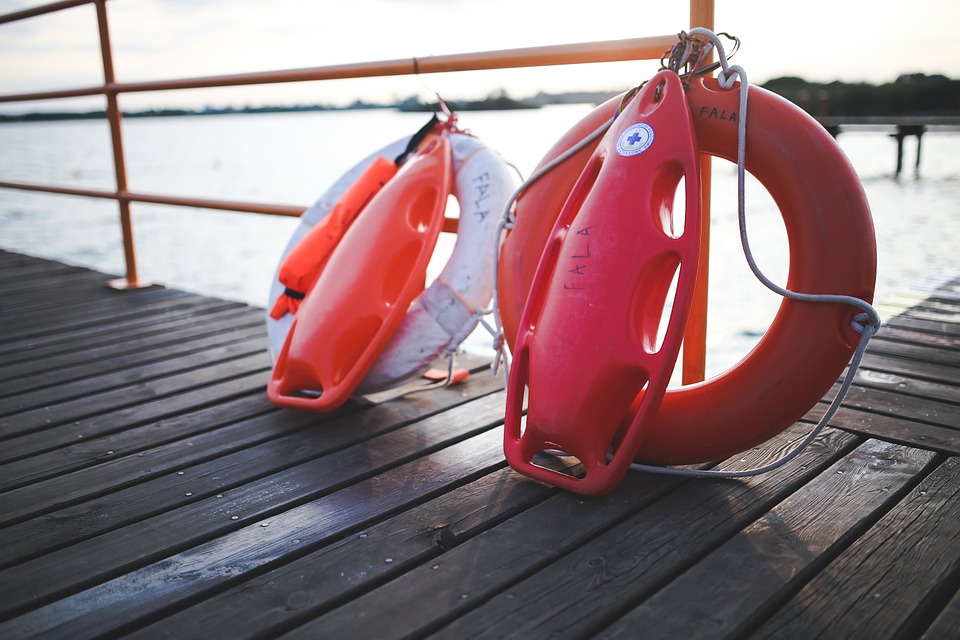
When the worst happens, are your travelers covered?
Being stuck in the middle seat or not being reimbursed for in-flight meals is nothing compared to the horror of missing a flight or your luggage.
These are two truly dreadful scenarios that companies need to be prepared for. We asked our European travel managers if their corporate insurance policy covers missed connections as a result of flight delays and delayed or lost luggage. The findings were interesting.
Only 23% of them had missed connections covered and 41% delayed or lost luggage. Depending on the country, you will have different regulations and policies regarding delays and cancelations, so it might be a good idea to review your corporate insurance to make sure that not everything is left at the goodwill of the airlines.
It is also important for your travelers to get 24 hour support and the right tools to rebook flights and other travel arrangements on the spot if the worst happens. Tools like our mobile app myCWT and our follow-the-sun approach for traveler support can play a crucial role when clients are confronted with a missed flight.
At the end of the day, safety and security are an essential part of any travel program. Such is so, that 17% of surveyed European travel managers reimburse travelers who purchase their own travel insurance.
Here again, it is better to work with a reputable insurance company to have a comprehensive package that does not require your travelers to get extra coverage for certain trips. Study your company’s routes and team up with safety and security specialists to determine what is needed.

The thrust of the sharing economy
Ground transportation is a key element of traveling and can be a source of stress for travelers. Depending on the destination, public transport or even a short walk can be a valid alternative, but it is very likely that, at some point, your travelers will need to hire a taxi or a ride-sharing service like Uber or Lyft.
The controversy about the latest has been hitting the front pages of newspapers all over Europe, so we wanted to know if our European clients allow their use.
Despite taxis still being the preferred method when it comes to ground transportation, 58% of travel managers claim they allow their travelers to use ride-sharing services.
This figure comes to prove these services widely used for personal journeys are entering the business space with force. Travelers love the convenience of these platforms. As a consequence an array of companies are investing in similar tech. Traditional taxis can benefit from being integrated into platforms that allow easy booking and provide direct invoicing. Thanks to this, travelers do not need to advance funds to pay for their rides.
In the end, it all leads to an improved travelers experience. The good news is that all the actors within the business travel ecosystem are working hard towards this goal. The advancement of technology coupled with first-class service is making it possible. A happy employee is a more productive one and one likely to be loyal and develop her talent. It’s all about experience, after all.
-
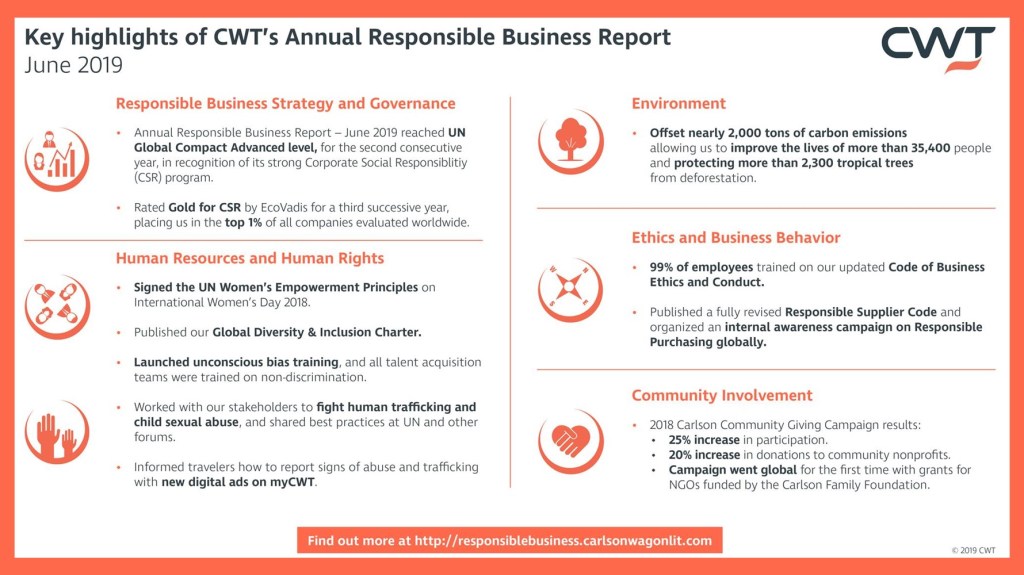
CWT’s June 2019 Responsible Business Report caps a successful year
CWT, the B2B4E travel management platform, has published its June 2019 Annual Responsible Business Report, following another successful year of Corporate Social Responsibility. The company reached its third consecutive annual EcoVadis Gold rating and the United Nations Global Compact Advanced Level rating for its annual Responsible Business Report.
“I continue to be amazed at the way we weave Responsible Business into everything we do,” said CWT’s President and CEO Kurt Ekert. “I am proud of the hard work and commitment shown by our teams around the world.”
Alongside the commitment to the United Nations Women’s Empowerment Principles, CWT recorded some significant milestones in 2018:
- offsetting nearly 2,000 tons of carbon emissions:
- improving the lives of around 35,500 people, and
- enabling the protection from deforestation of more than 2,300 tropical trees;
- 99% training completion of CWT’s Code of Business Ethics and Conduct among its 18,000+ employees;
- helping to combat human trafficking and child sexual exploitation by:
- working with partners like World Childhood Foundation and ECPAT, and
- sharing best practices at the United Nations and other forums;
- running a digital advertising campaign on the myCWT platform, showing travelers how to report suspected trafficking;
- launching two training programs on:
- unconscious bias for all employees, globally, and
- non-discrimination for talent acquisition teams worldwide;
- publishing the CWT Global Diversity & Inclusion Charter; and
- updating CWT’s Responsible Supplier Code, which sets environmental, social, and ethical standards within its supply chain.
CWT launched its Responsible Business strategy in 2012 with a clear set of commitments and goals, to deliver responsible value to all CWT’s stakeholders – clients, travelers, business partners, and employees.
CWT contributes to sustainability by supporting the United Nations Global Compact and the Sustainable Development Goals.
CWT’s Annual Responsible Business Report
Demonstrating CWT’s commitment to think, act, and live with integrity, the Annual Responsible Business Report covers CWT’s main achievements in its seven Corporate Social Responsibility (CSR) areas: Responsible Business Strategy and Governance, Ethics & Business Behavior, Human Resources, Human Rights, Environment, Community Involvement and Responsible Products and Services.
CWT is a leading global partner in business travel, meetings, and events. Operating across six continents, we deliver sustainable, tailored solutions that help organizations connect, engage, and thrive in an evolving world. Our myCWT platform integrates advanced technology with human expertise to simplify travel and enhance traveler and attendee experiences. Extensive global coverage, seamless data integration, AI-driven analytics, and carbon-conscious travel tools enable businesses to optimize their travel and meetings programs while delivering measurable value.
With 150 years of industry experience and a deep commitment to partnership, CWT collaborates with clients to shape the future of business travel and events, making them more efficient, responsible, and impactful.
- offsetting nearly 2,000 tons of carbon emissions:
-

We did it again – Our June 2019 Responsible Business report reached the United Nations Global Compact Advanced level
If you are reading this post, the chances that you have also seen that today we are announcing the publication of our June 2019 Annual Responsible Business Report are high.
The enthusiasm of all of us at CWT towards the goal of making our company a reference in Corporate Social Responsibility (CSR) have come together in a document where we proudly capture our many achievements.
This year we are extremely proud that our report has reached again the UN Global Compact Advanced level.
It proves that, since 2012 – when we first became a signatory to the UN Global Compact, we have been able to demonstrate our CSR holistic approach at a global level, as well as our will and strategy to continuously progress on each of the responsible business domains we cover: Responsible Business Strategy and Governance, Ethics and Business Behavior, Human Resources, Human Rights, Environment, Responsible Products and Services, and Community Involvement.
To reach this highest UN Global Compact level a company’s annual report needs to:
- Detail to stakeholders how the company lives up to its commitment to mainstream the 10 principles.
- Meet the UN Global Compact 24 Advanced Criteria by explaining how the company is implementing the Ten Principles into its Strategies & Operations, and how robust its Management Policies & Procedures are.
- Prove which of the 17 Sustainable Development Goals (SDGs) the company addresses through its activities.
- Be transparent in its communications and follow recognized reporting standards such as the Global Reporting Initiative (GRI).
- Demonstrate a solid, holistic approach to CSR, and show that it has implemented best practices and reported progress on some of the UN Global Compact’s advanced criteria.
- Be assessed by a third party.
Being a signatory of the Global Compact and achieving the Global Compact Advanced level demonstrates a solid commitment to CSR and is the most rewarding of efforts.
We invite you to join us and the thousands of companies that are today taking part in the UN Global Compact. Together, we can succeed at putting CSR at the center of business activity and contributing to a better world.
-
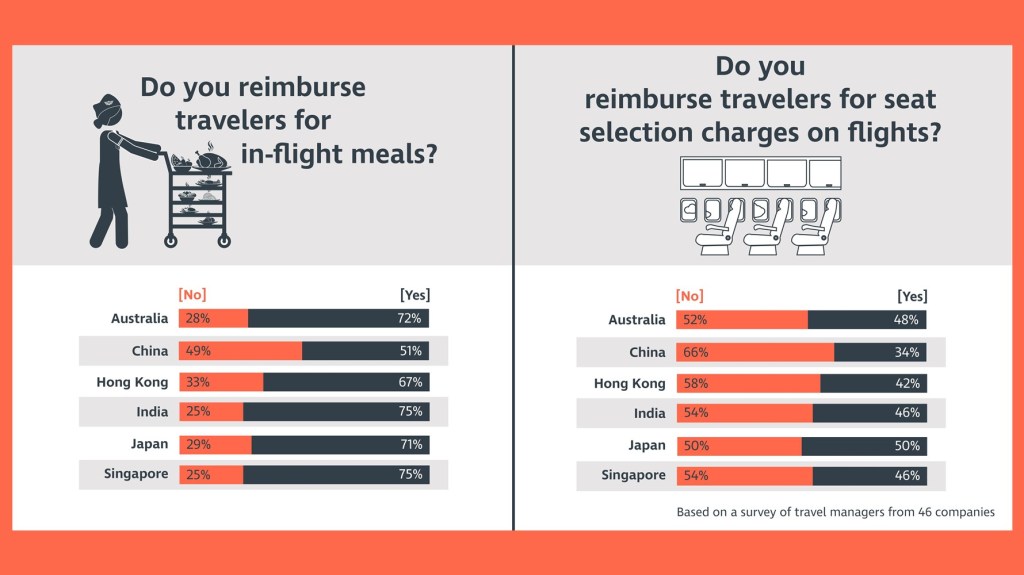
Making a bundle: How are travel programs in Asia Pacific responding to the trend of airlines charging for ancillaries?
Window or aisle? Would you prefer quicker access to the bathroom and your baggage or to not be disturbed and have a better view? And more importantly, should the company or the employee pay for the choice?
This question is becoming more of an issue for travel managers as both full-service and budget carriers bet on unbundling ancillaries as a strategy to maximize revenues. And currently, there’s not a consensus.
A CWT survey of travel managers from close to 50 companies in key Asia Pacific markets has found that they’re divided over whether or not to reimburse business travelers for seat selection, but they’re likely to pay for in-flight meals.
In every country, except for Japan (where travel managers are evenly split), a majority won’t pay for seat selection. In most markets it’s a fairly slim majority, but in China roughly two-thirds of companies won’t pay.
For meals, travel managers tend to be a little more generous, with a clear majority (in excess of 70%) agreeing to pay in all major markets, save one. China again is the outlier, with only 51% of travel managers paying for meals.
These numbers are clearly influenced by the travel market in question. In China, where a large proportion of trips are domestic, airlines typically don’t offer or charge for seat selection on domestic flights.
CWT’s Senior Director of Asia Pacific Multinational Sales Akshay Kapoor also suspects there’s a strong correlation between companies who pay for meals and seat selection, and those who use low-cost carriers in their travel program.
“When the organization decides to introduce low-cost airlines into their network or in their policies, they automatically start to open up to some of these obvious challenges that come along with it. Because low-cost airlines present an opportunity and a challenge,” he said.
Low-cost and full-service carriers converge
Unbundling is here to stay, and it’s likely to become a bigger issue for corporate travel programs.
Some of it is unavoidable. Even among full-service airlines, the overwhelming majority – including Singapore Airlines, Qantas, Air India, and Air China – now charge for advance seat selection on some of their lowest economy class fares. Baggage isn’t always included either. In fact, a report by CAPA – Centre for Aviation found that most full-service carriers (including British Airways, Finnair, Aer Lingus, Virgin Atlantic, Delta, Air France, KLM, Alitalia and Lufthansa) offer transatlantic tickets without a checked baggage allowance. Most recently, Emirates became perhaps the first in the industry to make a serious attempt at unbundling business class, introducing “Special” fares which cut certain features like lounge access and their chauffeur service.
And the landscape is becoming more complicated as low-cost and full-service carriers compete for the middle ground. Full-service carriers, who don’t want to cede their customer base to low-cost competitors, are increasingly offering unbundled discount fares.
At the same time, low-cost carriers have started to offer re-bundled tickets, where the customers pay a little extra for a package that might include an extra baggage allowance, a meal and seat selection.
What makes things trickier is that depending on the airline, the route and the point of sale, sometimes ancillaries may not be distributed through the global distribution systems (GDSs) and need to be booked directly through airlines’ websites. This makes it harder for travelers to compare like-for-like fares. That said, conversations are taking place between various parties across the travel industry to make these products and services available in the GDSs.
Navigating the new, unbundled reality
On the one hand, unbundling has resulted in increasing consumer resentment as services that were once included now cost extra. But it also means cheaper tickets. For travel managers, it means balancing costs against the need for a pleasant and productive trip.
Organizations need to establish clear guidelines about what their business travelers can reasonably accept and what the company will pay for. In most cases, the company should cover anything that would have been previously included in a bundled fare, such as baggage, seat selection and meals.
“I would advise travel managers to default to reimbursing for these things,” said Mike Valkevich, CWT’s Vice President of Global Sales and Program Management, Asia Pacific. “More often than not, it’s worth paying a little extra to ensure an employee travels comfortably and arrives at their destination in the right frame of mind.”
Of course, the company should set sensible limits. It might offer to pay for seat selection, but refuse to pay for a more expensive seat in an exit row. And paying for baggage doesn’t mean rubber stamping all requests.
“In the rare case where an employee incurs an excess baggage fee for bringing a pair of skis along to a business meeting in Hokkaido, it might warrant a deeper conversation with the line manager,” said Mr. Valkevich.
Companies should also carefully consider if they really gain anything from refusing to pay for meals or seat selection. It saves no money, for example, to refuse to pay for an in-flight meal if your employee has a meal allowance of $45 he or she can spend at the airport.
Once these policies are established, the company might try to negotiate a deal with the airline so that the ancillaries will be included. Success, of course, will depend on the airline and the market. In India, for example, it’s fairly standard for corporate deals to include seat selection and meals. In other markets, it might be trickier because budget airlines are much more focused on leisure travelers.
Finally, companies should be open to collecting data so that they can see whether or not their policies are effective.
Ultimately, Mr. Kapoor thinks it’s about striking a balance between cost and comfort.
“What does a good experience for my business traveler look like? Cost savings and experience need to be taken into account and we need to create a balance,” he said.
A quick glance at airlines’ seat selection policies, and charges for selecting standard seats (i.e. seats that are not including priority / front row / emergency exit / extra legroom seats)
Air China
Advance seat selection available free of charge on routes within Asia. Advance seat selection chargeable (RMB50-100) for seats towards the front of the economy cabin on routes to the Americas, Europe, Africa and Oceania.Any available Economy seat can be reserved for free once online check-in opens.
Air India
Advance seat selection chargeable for seats towards the front of the Economy cabin. Seats towards the rear of the Economy cabin can be reserved free of charge.Any available Economy seat can be reserved for free once online check-in opens.
All Nippon Airways (ANA)
Advance seat selection chargeable for passengers booked on certain fare classes (V, W, S, L and K) to reserve aisle and window seats towards the front of the Economy cabins. ANA Diamond Service and Platinum Service members are exempt.Aisle and window seats towards the back of the cabin can still be reserved for free.
Any available Economy seat can be reserved for free once online check-in opens.
British Airways
Advance seat selection chargeable for Economy (from GBP7), Premium Economy (from GBP18) and Business (from GBP20). Members of the Executive Club and other oneworld frequent flyer programs can reserve seats free of charge at different stages.Any available Economy seat can be reserved for free once online check-in opens, except for travelers on a “Basic” ticket.
Cathay Pacific Airways / Cathay Dragon
Advance seat selection chargeable (HKD60-330) for Economy passengers booked on certain fare classes (S, N, Q and O). Marco Silver members or above, and oneworld Ruby members or above, are exempt.Any available Economy seat can be reserved for free once online check-in opens.
China Eastern Airlines / Shanghai Airlines
Advance seat selection available free of charge on international flights. Not available on domestic flights.China Southern Airlines
Advance seat selection available free of charge on domestic flights.Advance seat selection chargeable (RMB30-100) for seats towards the front of the economy cabin on routes to the Americas, Europe, Africa and Oceania.
Any available Economy seat can be reserved for free once online check-in opens.
Delta Air Lines
Advance seat selection for preferred seats towards the front of the Economy cabin is chargeable.Other Economy seats can be reserved in advance for free, except by passengers on a Basic Economy ticket who will have to pay a fee.
Emirates
Advance seat selection chargeable (USD25-80) for passengers booked on “Flex”, “Special” and “Saver” fares to reserve seats towards the front of the Economy cabin. Emirates Skywards Gold members and above are exempt.Advance seat selection chargeable (USD15-35) for passengers booked on “Special” and “Saver” fares to reserve other Economy seats. Emirates Skywards Silver members and above are exempt.
Any available Economy seat can be reserved for free once online check-in opens.
Etihad Airways
Advance seat selection chargeable (AED100-130) for passengers booked on “Economy Deal”, “Saver” and “Classic” fares.Any available Economy seat can be reserved for free once online check-in opens.
Hainan Airlines
Advance seat selection chargeable (RMB100-600) for seats towards the front of the economy cabin on international routes. Hainan Silver Frequent Flyers and above can reserve some seats for free on certain routes.Indigo Air
Advance seat selection is chargeable (INR100-800 on domestic flights; INR 250-1000 on international flights).Some middle seats can be reserved free of charge.
Japan Airlines
Advance seat selection available free of charge, except for passengers booked on the “O” fare class in Economy.Jetstar Airways
Advance seat selection is chargeable for “Starter” fares. Standard seats can be reserved for free with “Starter Plus”, “Starter Max” and “Flex” fares.Lufthansa
Advance seat selection chargeable (EUR17-55 for seats towards the front of the Economy cabin, and EUR 10-35 for other Economy seats).Charges are waived for Economy Classic and Economy Flex passengers, and Senators and HON Circle members of Lufthansa’s Miles & More Frequent Flyer Program, depending on the route.
Any available Economy seat can be reserved for free once online check-in opens.
Malaysia Airlines
Advance seat selection chargeable (RM11-100) for all standard Economy seats. Enrich Platinum members are exempt.Qantas Airways
Advance seat selection chargeable (AUD15-35) for “sale fares” in international Economy. Qantas Silver members and above, and oneworld Ruby / Emirates Skywards Silver members and above, are exempt.Any available Economy seat can be reserved for free once online check-in opens.
Qatar Airways
Advance seat selection for preferred seats towards the front of the Economy cabin is only available to Qatar Airways Privilege Club Silver members and above, oneworld Ruby members and above, and passengers paying the highest Economy fares.Any available Economy seat can be reserved for free once online check-in opens.
Shenzhen Airlines
No advance seat selection. Seats can be reserved for free once online check-in opens.Singapore Airlines
Advance seat selection chargeable (from USD8) for passengers booked on “Standard” and “Lite” fares to reserve seats towards the front of the Economy cabin. PPS Club and KrisFlyer Elite Gold members are exempt.Advance seat selection chargeable (from USD5) for passengers booked on “Lite” fares to reserve other Economy seats. PPS Club, KrisFlyer Elite Gold and KrisFlyer Elite Silver members are exempt.
Any available Economy seat can be reserved for free once online check-in opens.
Spicejet
Advance seat selection is chargeable (INR99-1000 on domestic flights; INR 250-1000 on international flights).Thai Airways
Advance seat selection is not permitted.Any available Economy seat can be reserved for free once online check-in opens.
United Airlines
Advance seat selection for preferred seats towards the front of the Economy cabin is chargeable (from USD9).Other Economy seats can be reserved in advance for free, except by passengers on a Basic Economy ticket who will have to pay a fee.
Compiled based on information provided by the airlines and/or information available on their websites on 19 June 2019. CWT does not take responsibility for the accuracy of this information.
-
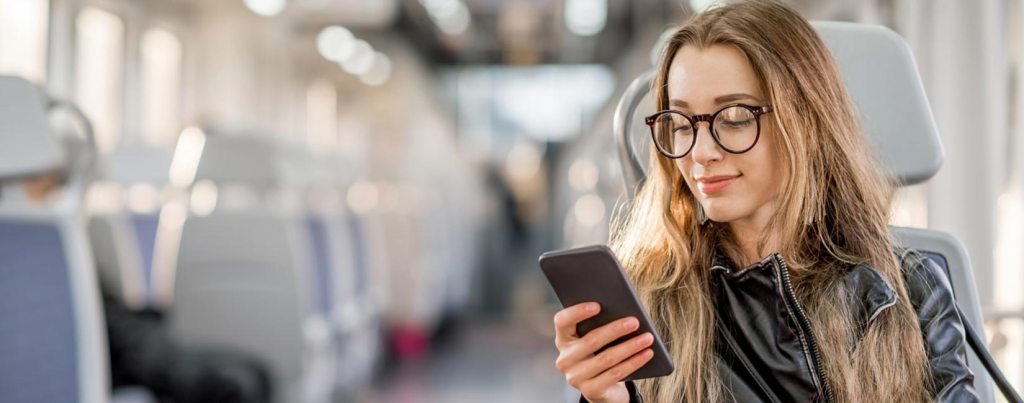
The gaps between travel buyers and their travelers
Why travel buyers struggle with hotel programs
In a joint study with GBTA, RoomIt has identified a number of gaps that exist between travel buyers and travelers. These gaps help explain why travel buyers struggle with improving traveler satisfaction, increasing compliance and reducing costs in their hotel programs.
Understanding these gaps, and how to address them, will go a long way in helping you achieve your goals
Traveler Satisfaction
26% of travel buyers
believe finding lodging near their destinations is challenging for travelers

73% of business travelers
say finding lodging near their destinations is challenging
How to close this gap:
Providing accommodations and rates in more locations is the best way to alleviate your travelers’ concerns.
Compliance
79% of travel buyers
require corporate booking channel use

34% of business travelers
know corporate booking channels are required
How to close this gap:
Make sure your policy is concise, clear and broadly communicated so travelers know what they must book and where.
Cost
67% of travel buyers
recommend or require refundable rates to be booked

67% of business travelers
would like to book non-refundable rates because they feel it saves money
How to close this gap:
Allowing non-refundable rates can lower costs and increase compliance, but educate travelers about when they should be booked.
-

Spirit of Punk – Does your travel program encourage originality?
The Sex Pistols is an iconic band responsible for initiating one of the most important, controversial and influential movements in modern culture: Punk.
The genre resonated with the young working class across Europe, as people became disenchanted with the stiff and accepted way of doing things. Punk was about adopting a do-it-yourself ethic, rejecting the ‘norm’, and in the Seventies, this sub-genre attracted hordes of young people overwhelmingly invested in the process of identification, fragmentation, and originality.
Now that sense of being ‘original’ is not exclusively linked to the Punk movement, it is still alive in many parts of society and so is the idea of doing things ‘my way’ or being recognized as different. It’s natural then that this feeling is not going to stop on Monday morning when you stare in the mirror with your razor blade, put on your shirt and tie and head to work.
Power to the people
That phrase ‘our people are our most important asset’ is a well-worn one by those in HR. We love to celebrate how our employees outshine those of our competitors and how we let them ‘express themselves’ and ‘encourage innovation.’ But for many, this does not translate into our travel programs. Employees are squeezed into the same boxes.
According to CWT Solutions Group, 15% of your air spend could be saved if your travelers booked within the policy, so uncover those travelers that don’t and identify the reasons why. Taking a deeper look into traveler data, based on information saved in their profile allows you to understand trends and identify sub-sets of travelers, such as those who book chronically late, or stay loyal to hotels that are not in your program. Understanding their preferences is increasingly important with personalization. Shopping is now expected, not just preferred. Enhancing the knowledge around a traveler will help build a nuanced profile that goes beyond the usual categories of age, gender and job level.
Profiling also helps you address issues in certain groups and create a clearer picture of your traveling employees. This is a first step in meeting their needs and designing a more specific and unique program that reflects all your ‘traveler tribes’.
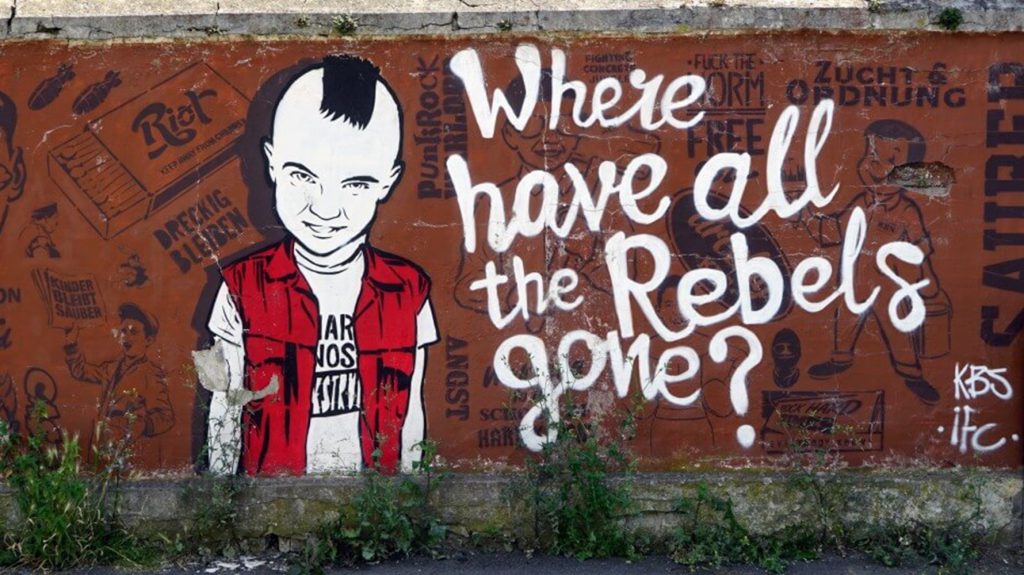
Serve the Sub-sets: Travelers are individuals with different needs and preferences Preferences matter
A CWT study shed some light on certain traveler preferences. It showed 65% of European travelers preferred the window seat to an aisle seat when flying and almost 70% preferred traditional taxis over ridesharing firms such as Uber and Lyft. Now, of course, these two figures alone are not suddenly going to give you massive savings, but taking a holistic view of your data can ensure your travel program is generating more bang for your buck.
A one-size-fits-all approach no longer cuts it with today’s business travelers, they are individuals with different needs and preferences, so treat them that way and build a program that represents this…Punk Is Dead. Long Live Punk.
Download CWT’s Traveler Tribes eBook showing how to meet the needs of different traveler types.
-

On the safe side – Taking a more complete view of safety and security for Meetings and Events
In an era where the mere mentions of terrorism, viral epidemic, natural disaster, or political unrest reverberate around the world, the topics of safety and security have entered our daily discourse. Meetings and events are no different, realms where the real, practical necessity of protection from harm lands firmly center stage. After all, delegates and attendees must feel free from any perceived or actual risk, liberated from all concerns surrounding their wellbeing. That is easier said than done and ensuring the safety of guests is a complex, multi-layered undertaking, riddled with questions in search of workable answers. What measures can companies in Asia take to ensure the safety and security of attendees? Are these measures enough and if not what improvements can be made?
“There still isn’t an all-encompassing solution to manage safety and security for meetings and events,” notes Sam Lay, Senior Director, Asia Pacific, CWT Meetings & Events. “The measures are simply part of a larger or more generic scheme that arise from likes of insurance coverage. There needs to be more awareness. Safety and security is not at that level yet, where it is part and parcel of planning and we need a few key organizations to set the stage here.”
Typically, points out Petrina Goh, Director, Singapore, CWT Meetings & Events, planners look at travel restrictions and advisories placed on countries and cities by the likes of consulates, ministries and other organizations that assess travel risks, and use these as pointers as to where delegates can and cannot go, “but generally planners don’t look beyond that. It’s very fragmented.”
Yet it is critical that they do. Safety and security requires interpreting many facets, among them variables like general physical health, electoral cycles, weather patterns, security of the venue and its vicinity, fire safety, exit points, doctors, the security team in-house, each of which can play a significant role in the suitability of a destination. Some industries are more sophisticated than others in their interpretation and knowledge of these factors.
“Industries with mature security include oil and gas and pharmaceutical companies,” explains Goh. “Pharma companies usually include emergency hotlines in all event collateral, the emergency number in the city where the event is taking place, and the address of the nearest hospital. We encourage all planners to include this information in their event collateral.”
“There is a culture of safety and security already in industries like oil and gas and it transcends into other parts,” says Lay. He believes that whatever the industry, a planner must go beyond the reactive side of planning and look at what is happening on the ground and on site during the pre-event phase. “For instance, if you were going to Thailand and Indonesia during election times, you need a very advanced view. We would look at on-site threats and potential routes for evacuation. If you are off-site, the concerns are vastly different from a business-travel city scenario.”
For Aditya Luthra, Security Director, Asia, International SOS and Control Risks, planners face multiple challenges. “Organizations are increasingly choosing to travel and host events outside capital cities or major commercial metropoles, and the access to medical care might be sub-par compared to major commercial centers and the security environment can be more variable.” He also notices a change in the demographic at events, with increasing female and LGBTQ participation, which has implications for how planners address the security considerations for their events. “Organizations have a legal and moral responsibility to provide pre-travel training and knowledge to minimize risk in locations, and protect attendees and delegates from harm’s way as far as possible.”
“We screen tour operators, check their safety records. We have to look at things like whether it is safe to put delegates on a boat or in a cable car. A planner is responsible for the safety of attendees for every minute,” declares Goh. For events in public areas, where delegates might come into contact with city residents, planners need to mitigate risks like pick-pocketing and petty crime. In the end, guaranteeing that safety requires sifting through information that is both macro and micro, from the general level of crime at a destination to ensuring that a venue can cater to a delegate that has a peanut allergy, for instance. And for each scenario, there needs to be a contingency plan, even for destinations that seem completely safe. “There are a lot of considerations in addition to just the destination itself,” mentions Goh. “There is perception with a lot of our planners that if a destination is ok, then everything else is OK.”
Singapore is seen as incredibly safe — which it is — but last year a number of diners suffered food poisoning at a well-known luxury hotel in the Lion City. Nowhere is completely accident-free and planners must be receptive to talk about subjects that might be difficult. “What happens if something does go wrong,” says Goh. “Planners must understand where the liability will fall should things go wrong. The legal and reputation repercussions are big considerations and we notice a move away from the adventurous traveler to the adventurous but cautious traveler.”
Thankfully companies now increasingly strive to show duty of care. “Markets like Western Europe, North America, Australia, Japan and Singapore have strong duty-of-care cultures,” notes Luthra. “In China, India, Thailand, and Indonesia, we are seeing a significant growth in recognition of duty of care among organizations.”
Hotels run through a gamut of procedures with planners to ensure they meet the requirements of an event and their guests’ security. Stanley Ng, Director of Sales, MICE International Sales Office Singapore for Accor, believes it is key to arrange a “prior site inspection and meeting with the meeting planner, as well as involving both safety and security teams of the company and hotel to review hotel’s security procedures and policy.” Other measures include conducting physical checks of passport details when guest check-in, ensuring key card access is only to the designated floor in which the guest is accommodated during their stay, physical and regular patrols by security officers around the hotel for deterrence purposes, and the use of CCTVs for regular surveillance of the hotel premises at all times. Luthra feels that planners should not rely just on branding, but do actual due diligence checks on properties they plan to use for an event. And they should study every component of an event — the hotel, venues, activities and transport between each point.
For an overview of a destination, the best source of information isn’t necessarily the tourist board which has a vested interest to paint a positive picture of the city, region, or country it represents, but national governmental agencies and companies that conduct independent analyses. In Singapore, the Ministry of Foreign Affairs lists travel advisories on its website, dissemination of information that is not designed to instill fear but to show responsibility and allow its citizens to make calculated decisions. For Caitrin Moh, Senior Mice Manager at the Korea Tourism Organization, “on the safety and security in meetings and events, we follow the travel alerts issued by the Ministry of Foreign Affairs, be it in Singapore or Korea.” She points to the reliability of information of such government bodies. “I was in Korea for business trips during the North Korea-South Korea tension in 2015 and MERS in 2016. Daily life and business were as usual, but the media sensationalized the stories. The ministry’s travel advisory publicly shared that Korea was safe to travel to.”
International SOS offers intelligence on medical and travel security risks in destinations around the world. It also provides on-the-ground support such as secured transport, medical assistance and evacuations. Companies often approach it prior to an event for tailored assessments and advice on how to manage any anticipated risks, which factor in the destination, itinerary, travel dates and travelers’ profiles. “We have an app that sends delegates push notifications in real-time about destination-specific medical and security risks, and also provide advice on how they should respond,” says Luthra. And incidents seem increasingly likely to take place, according to the recent Business Resilience Trends Watch 2019 survey by Ipsos MORI. Forty-three percent of the surveyed organizations, including event organizers, said they expect travel risks to rise in 2019, with issues like security threats, national disasters, and extreme weather topping the list. “Preparing delegates and attendees for the risks they might encounter while traveling is important. It is also incumbent on management to know how to respond when an incident takes place.”
Yet, even with all the planning and pain-staking analysis derived from multiple sources, not everything can be controlled. Delegates and attendees often view free time as sacred, moments when they can remain anonymous and have control of their schedule; during those periods, it’s hard for organizers to police their every movement. In such cases, planners should still advise delegates on things like areas that should be avoided or ways to behave in public.
-

Eastern promise – How to manage your hotel program in Asia-Pacific
We all know that Asia Pacific (APAC) is the fastest growing region in the world. Incredibly it accounts for two-thirds of total global growth, which means many companies will be increasing their travel to and within the region. The problem is that managing travel in APAC is probably more complicated than in any other region in the world.
Below are some tips that will help travel managers better understand and respond to the complexities that await them when managing travel in this region.
Mobile adoption is high in China
98% of Chinese internet users access it via mobile, and 90% of CWT client bookings in China are made online or with mobile booking platforms. To support this high mobile usage, it’s important that you or your travel management company is partnered with a Chinese-based travel technology company such as TravelSky. Despite China’s high adoption, not all of APAC is on the same page.
Payment is complex
While the Chinese increasingly use their phones for everything, it’s especially important to appreciate the widespread use of mobile pay. There are restaurants that only accept mobile pay, and even the street vendors prefer payment via mobile phone. It may be necessary to have travelers in the region set up WeChat Pay or Alipay, or visitors to the region may have to rely on a local to pay for meals and taxis.
Again, despite this high mobile pay adoption in China, secondary and tertiary cities in other countries will only accept cash. Setting per diems for food and taxis may be a necessity in these areas.
GDSs aren’t sufficient for Australia
90% of business travel in Australia is to major cities, but 10% of travel is to smaller cities and towns with limited supply of any type. These areas present problems for hotel programs that rely solely on the GDS. RoomIt can fill these gaps in coverage by adding content from third parties. The results have been very promising as one client, for example, saw their hotel attach rate within Australia increase by nearly 10%.
Some countries pose a high travel risk
Some countries and parts of a number of other countries within Asia and the South Pacific come with high travel risks or government warnings.
For example, Myanmar and portions of the South Pacific nations present high travel risk to travelers. Most of India is deemed safe, but parts of the country still rank as unsafe for women traveling alone.
Some travel safety tips:
- Learn local customs and etiquette
- If you can, start and end your days early to avoid being out at night
- Avoid street food and tap water in places with low hygiene standards
- If taking the train, purchase the highest-class train tickets in advance
Need tips for managing hotel programs in APAC? Check out our guide here.
-
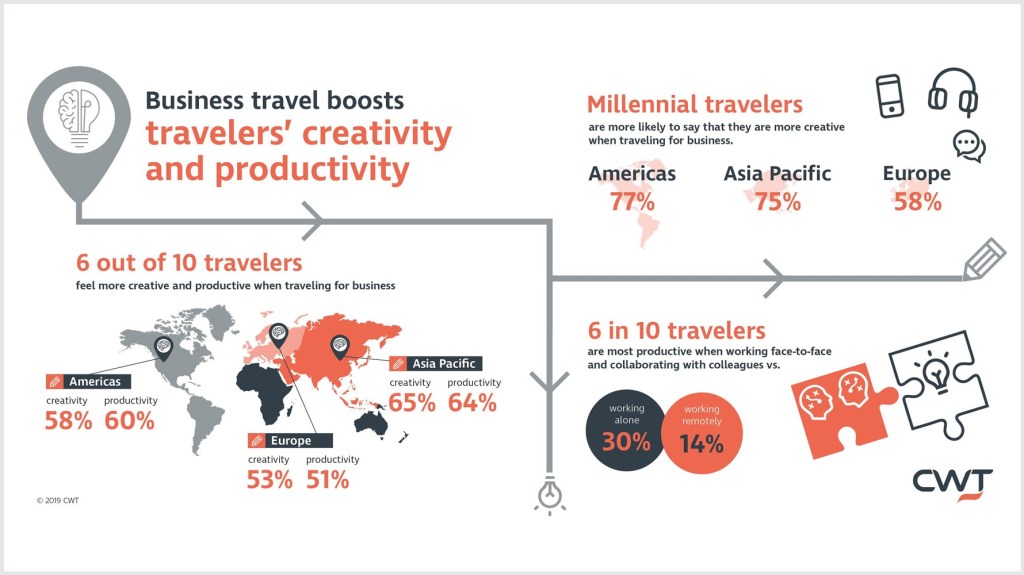
CWT research reveals business travel stimulates creativity and productivity, especially among millennials
Research by CWT, the B2B4E travel management platform, shows that six in ten travelers feel more creative and productive when traveling for business.
Millennial travelers are more likely to say that they are more creative and productive when traveling for business. Those in the Americas lead the way (77% feeling more creative and productive), followed closely by those in Asia Pacific (75% feeling more creative and 73% more productive). European millennials rank third (58% and 57% respectively).
“We are proud to be in a business that helps bring out the best in people,” said Niklas Andreen, Executive VP and Chief Traveler Experience Officer at CWT. “These findings are not a surprise – travel energizes people, fosters fresh thinking, creates connections – and nothing beats a face-to-face meeting.”
Overall, travelers from Asia Pacific are more likely to have increased creativity (65%) and productivity (64%) compared to travelers from the Americas (58% and 60% respectively) and Europe (53% and 51% respectively).
CWT’s research also shows that six in ten travelers are most productive when working face-to-face and collaborating with colleagues as opposed to working alone (30%) or remotely (14%). Asia Pacific travelers’ productivity benefits the most from working face-to-face: 61% versus 53% for travelers from the Americas and Europe.
CWT is a leading global partner in business travel, meetings, and events. Operating across six continents, we deliver sustainable, tailored solutions that help organizations connect, engage, and thrive in an evolving world. Our myCWT platform integrates advanced technology with human expertise to simplify travel and enhance traveler and attendee experiences. Extensive global coverage, seamless data integration, AI-driven analytics, and carbon-conscious travel tools enable businesses to optimize their travel and meetings programs while delivering measurable value.
With 150 years of industry experience and a deep commitment to partnership, CWT collaborates with clients to shape the future of business travel and events, making them more efficient, responsible, and impactful.